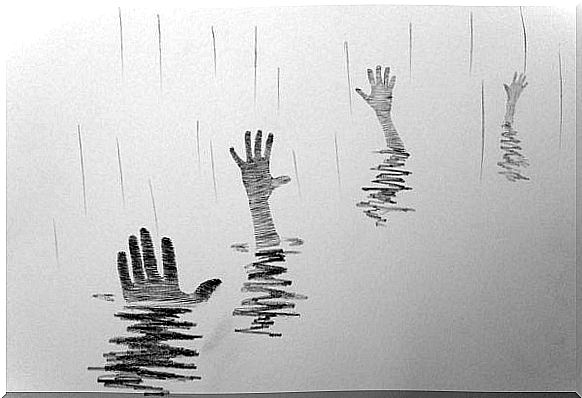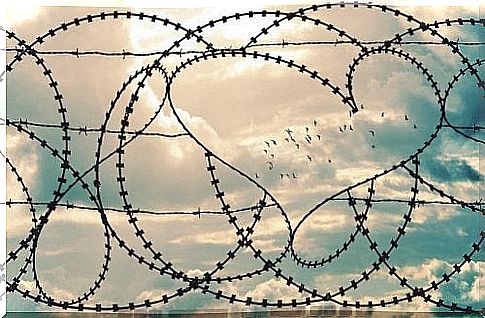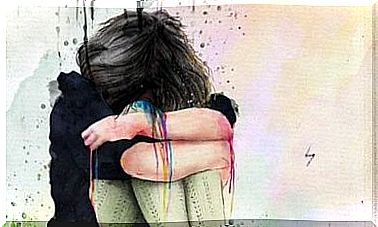What Is Behind Emotional Dependence?

We are all dependent from the moment our life begins. In our mother’s womb and the first time we cry. When we first fall and during our first encounters with unknown worlds. We are practically and emotionally dependent. We need other people to do things for us or show us how to do them. We all need different people because we are social and emotional beings. Does this mean that we are necessarily victims of emotional dependence?
Nothing can cause as much emotional turmoil as another human being can. Think of your first kiss, seeing someone for the first time in years, or a soothing hug. You breathe, I breathe, we breathe.
As teenagers, we fight hard for our independence. Then we realize that true independence is not possible. Our primary needs do not respond well to independence. Think of love and affection, encounters and disagreements. Creating a utopia for independence would not be good for us.

Emotional Dependence: A Fact of Life, or Our Chains
So if emotional dependence is a natural thing, why does psychology treat it as a problem to be avoided? One reason is that psychology is not immune to societal trends. These trends are becoming more individualistic. Another reason is that dependence can become something negative when fixated on a particular person. When we give someone else the responsibility to handle the whims and appetites of our inner child and we think that person is irreplaceable.
Let’s look at a simple example. Anna thinks it’s time for some changes in the furnishing of her home and she would like to move a piece of furniture. It’s too heavy for her to move on her own. She needs someone else’s help. She could help herself by studying physics and mechanics and building a jack on wheels to move the furniture. However, that solution does not currently apply.
The most obvious solution is to find people who are stronger than themselves. Anna thinks about her children, but they are on vacation. Instead, she asks her cousins for help and they are happy to help her. So Anna is dependent, but she is not dependent on her children. If they can’t, she is able to seek help elsewhere. The same happens with emotional independence/dependence.
It becomes dangerous when we depend on one person. When we expect him to take responsibility for our emotional state. It is dangerous because it weakens us. In the long run, it will ruin the relationship. However, the worst happens before the relationship ends. We will destroy ourselves with desperate measures to avoid losing the person our happiness depends on.
The Four Steps of Emotional Dependence
The road to emotional destruction caused by dependence generally consists of four distinct steps. We begin to take these steps when we begin to fear loss. This kind of fear is usually unfounded and makes dependence even stronger.

The first step for a dependent person is to make himself indispensable to the person on whom he depends. He constantly mentions and highlights the contributions he makes to the life of the other. ‘If you didn’t have me…’, ‘Who else would do this for you?’, ‘You can try, but you will never find someone like me.’
The dependent can also try to become a kind of guarantee or insurance. “If you stay with me, you will never lack for anything.” He tries to get the other person to stay with him, even if it’s just for some benefit.
We walk down to the second step if the first step doesn’t work. The second can also continue to work in tandem with the first. In this step, the dependent plays the victim to get pity. His daily struggle turns into a true tragedy. If the other person tries to leave during these moments, he looks like a monster. This is usually a strategy that a dependent knows well and has probably used before to get attention.
The third and fourth steps are paradigmatic. With these steps, he tries to protect himself from what he fears most: indifference. These two steps are interchangeable. They can happen at the same time, the order is not important.
In addition, both steps refer to primal emotions: hate and fear. Fearing indifference, the dependent tries to make the other hate him. It is a form of self-deception. He wants to be present in the life of the other. He tries to create a lasting feeling and connection, even if the feeling is hate.
The fourth step is making threats. ‘If you even think about leaving, I don’t know what I’ll do’, ‘If you disappear, I have no reason to live’, ‘If you decide to leave, I promise you you’ll never see me again you’ll see,” “You better not cry when I’m gone.” The dependent person tries to spread his fear of loss. This fear is nothing more than deceit, but it serves as a substitute for love.
The dependent person suffers and makes others suffer
Somehow the dependent person is tortured by his own dependence. If he is a victim of anything, it is his hope and entrusting his fate to someone else. This forces him to sacrifice himself so that that person does not leave. He really feels that if the other person leaves, he will lose his life. Much of what he says is manipulative, but behind it lies the real suffering.
Unfortunately, it is difficult to admit emotional dependence. There is a risk that you will be called cowardly, weak of character or even stupid. Still, establishing dependency is the first step to recovering it. The key lies in understanding that while our needs are unique, there are many who can meet them and the ways in which they can be satisfied are varied.









